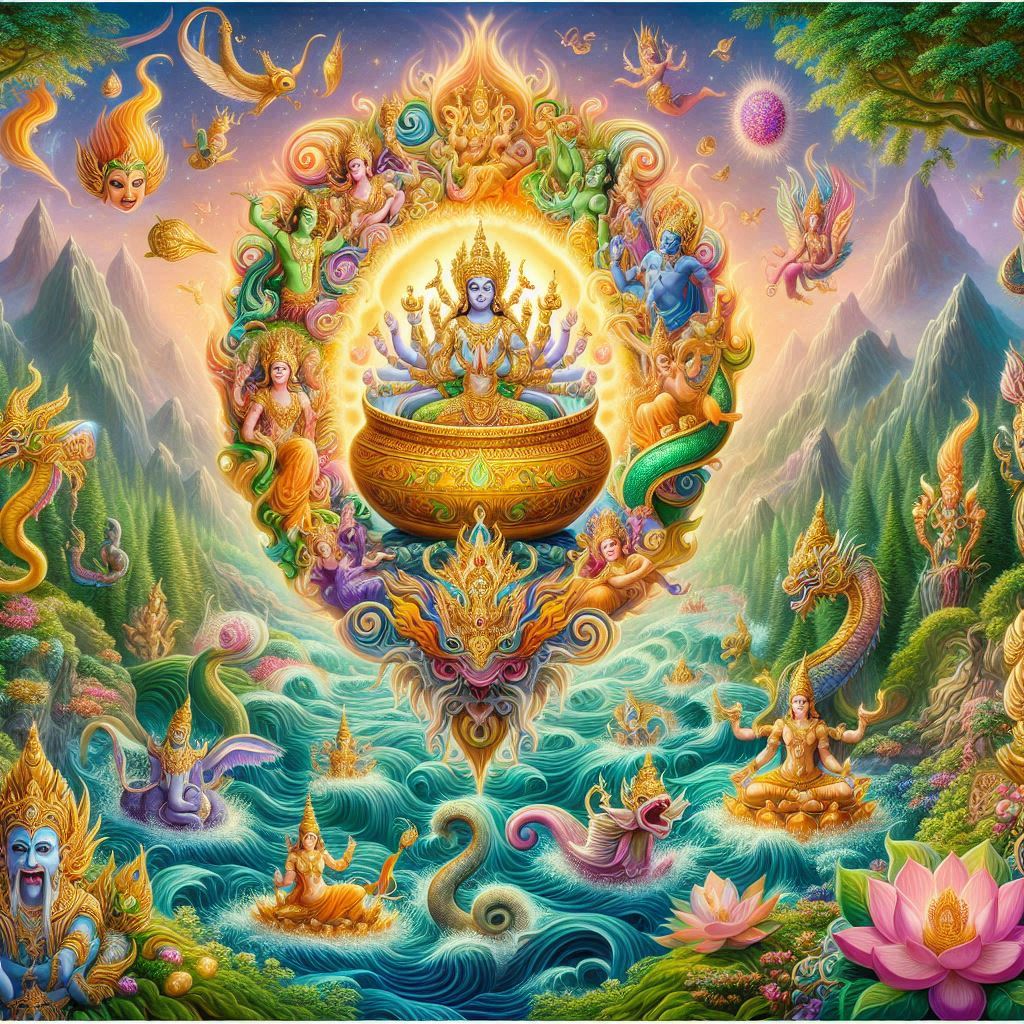
THE STORY OF SAMUDRA MANTHAN
The Background: Why the Churning Happened
Long ago, the Devas (gods) and Asuras (demons) were constantly at war. The Devas, led by Indra, the king of the heavens, had lost their strength and immortality due to a curse by the sage Durvasa. The Asuras, led by Bali, saw this as an opportunity to dominate the universe.
The Devas approached Lord Vishnu, the preserver of the universe, for help. Vishnu advised them to churn the cosmic ocean (Kshira Sagara) to obtain Amrita, the nectar of immortality. However, Vishnu warned that the Devas could not do this alone—they would need the help of the Asuras.
The Plan: Collaboration Between Devas and Asuras
Vishnu suggested that the Devas and Asuras work together to churn the ocean. The plan was simple but ambitious:
-
Use Mount Mandara as the churning rod.
-
Use the serpent Vasuki as the churning rope.
-
The Devas would hold one end of Vasuki, and the Asuras would hold the other.
-
The churning would release the treasures hidden in the ocean, including Amrita.
The Devas and Asuras agreed to share the Amrita once it was obtained, though both sides secretly planned to keep it for themselves.
The Preparation: Setting the Stage
The Devas and Asuras uprooted Mount Mandara and placed it in the cosmic ocean. However, the mountain began to sink into the ocean floor. Seeing this, Lord Vishnu took the form of a giant turtle (Kurma Avatar) and supported the mountain on his back.
Next, they wrapped the serpent Vasuki around the mountain. The Devas held Vasuki’s tail, and the Asuras held his head. As they began to churn, Vasuki’s fiery breath caused the Asuras to suffer, while the Devas remained unharmed.
The Churning Begins: Treasures and Challenges
As the churning began, the ocean started to yield its treasures. However, the process was not easy. The first thing to emerge was a deadly poison called Halahala, which threatened to destroy the universe.
-
Shiva’s Sacrifice:
To save the world, Lord Shiva drank the poison. His consort, Goddess Parvati, held his throat to prevent the poison from spreading, turning his throat blue. This is why Shiva is also called Neelkantha (the blue-throated one).
The Emergence of Divine Treasures
After the poison was neutralized, the ocean began to yield its treasures:
-
Kamadhenu (The Wish-Fulfilling Cow):
A divine cow that could grant any wish. It was claimed by the sages. -
Uchhaishravas (The Divine Horse):
A seven-headed white horse, which was taken by the Asuras. -
Airavata (The White Elephant):
A majestic elephant with four tusks, claimed by Indra. -
Kaustubha (The Divine Jewel):
A radiant gem that adorned Lord Vishnu’s chest. -
Kalpavriksha (The Wish-Fulfilling Tree):
A tree that granted all desires. It was planted in Indra’s garden. -
Lakshmi (The Goddess of Wealth):
The ocean gave birth to Goddess Lakshmi, who chose Lord Vishnu as her consort. -
Apsaras (Divine Nymphs):
Beautiful celestial dancers who entertained the gods. -
Varuni (The Goddess of Wine):
The Asuras claimed her, which led to their intoxication.
The Final Treasure: Amrita (The Nectar of Immortality)
After much effort, Dhanvantari, the divine physician, emerged from the ocean holding a pot of Amrita. The Devas and Asuras immediately began to fight over it.
Vishnu’s Intervention: The Mohini Avatar
To prevent the Asuras from obtaining the Amrita, Lord Vishnu took the form of Mohini, a mesmerizing enchantress. Mohini distracted the Asuras and offered to distribute the Amrita fairly.
-
The Trick:
Mohini gave the Amrita to the Devas but denied it to the Asuras. However, one Asura named Rahu disguised himself as a Deva and drank the nectar. The Sun and Moon gods noticed this and alerted Vishnu, who immediately beheaded Rahu with his Sudarshan Chakra. -
The Aftermath:
Rahu’s head became immortal, while his body died. This is why Rahu is said to chase the Sun and Moon, causing eclipses.
The Outcome: Victory for the Devas
With the Amrita in their possession, the Devas regained their strength and immortality. They defeated the Asuras and restored balance to the universe.
The Symbolism of Samudra Manthan
The story of Samudra Manthan is rich with symbolism:
-
Mount Mandara: Represents the axis of the world or the spine in yoga.
-
Vasuki: Symbolizes the Kundalini energy.
-
Halahala: Represents the challenges and negativity we must overcome.
-
Amrita: Symbolizes the ultimate goal of spiritual enlightenment.
-
Mohini: Represents the power of illusion (Maya) and the need for discernment.
Lessons from Samudra Manthan
-
Collaboration: Even enemies must work together to achieve great things.
-
Perseverance: The path to success is filled with challenges, but persistence leads to rewards.
-
Discernment: Not all that glitters is gold; true wealth lies in spiritual wisdom.
-
Balance: The universe operates on the balance of opposites—Devas and Asuras, creation and destruction.